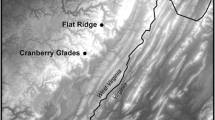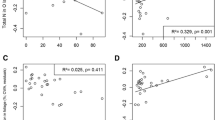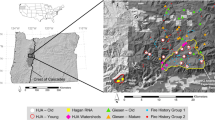Abstract
The relationship between herbivores, plants and nutrient dynamics, has been investigated in many systems; however, how these relationships are influenced by changing climate has had much less attention. In the northeastern USA, both moose populations and winter climate have been changing. Moose, once extirpated from the region, have made a comeback; while locally, snow depth and duration of snow cover have declined. There is considerable uncertainty in how these changes will interact to influence forested systems. We used small experimental plots and transects along with snow removal (to elicit soil freezing and expose potential forage plants), mechanical browsing, and fecal additions (labeled with 15N) to examine ecosystem responses. We found that snow removal changed moose browsing behavior, with balsam fir more heavily browsed than sugar maple or Viburnum under low snow conditions. Soil freezing alone did not significantly alter N dynamics or selected plant responses, but there were significant interactions with moose activity. The combined effects of moose fecal additions, mechanical browsing, and soil freezing resulted in higher levels of NO3 − leaching under fir and maple, whereas Viburnum had essentially no response to these multiple factors. Our results suggest that declines in snow depth can initiate a cascade of ecosystem responses, beginning with exposure of plants to increased browsing that then triggers a series of responses that can lead to higher N losses, precipitated by decreased N demand in plants compromised by soil freezing damage. Balsam fir may be particularly susceptible to this cascade of multiple stresses.



Similar content being viewed by others
References
Aber JD, Melillo JM. 1980. Litter decomposition: measuring relative contributions of organic matter and nitrogen to forest soils. Can J Bot 58:416–21.
Bakker ES, Olff H, Boekhoff M, Gleichman JM, Berendse F. 2004. Impact of herbivores on nitrogen cycling: contrasting effects of small and large species. Oecologia 138:91–101.
Bardgett RD, Wardle DA. 2003. Herbivore-mediated linkages between aboveground and belowground communities. Ecology 84(9):2258–68.
Belovsky GE, Slade JB. 2000. Insect herbivory accelerates nutrient cycling and increases plant production. Proc Natl Acad Sci USA 97(26):14412–17.
Bergman M. 2002. Can saliva from moose, Alces alces, effect growth responses in the sallow, Salix caprea? Oikos 96:164–8.
Bergstrom R, Danell K. 1987. Effects of simulated winter browsing by moose on morphology and biomass of two birch species. J Ecol 75:533–44.
Bohlen PJ, Groffman PM, Driscoll CT, Fahey TJ, Siccama TG. 2001. Plant–soil–microbial interactions in a northern hardwood forest. Ecology 82:965–78.
Bontaites K. 2003. Personal communication. New Hampshire Fish and Game Department—Moose Project.
Brandner TA, Peterson RO, Risenhoover KL. 1990. Balsam fir on Isle Royale: effects of moose herbivory and population density. Ecology 71:155–64.
Brookes PD, Stark JM, McInteer BB, Preston T. 1989. Diffusion method to prepare soil extracts for automated nitrogen-15 analysis. Soil Sci Soc Am 53:1707–11.
Brooks PD, Williams MW, Schmidt SK. 1998. Inorganic nitrogen and microbial biomass dynamics before and during spring snowmelt. Biogeochemistry 43:1–15.
Bryant JP, Reichardt PB, Clausen TP. 1992. Chemically mediated interactions between woody plants and browsing mammals. J Range Manag 45:18–24.
Cabrera ML, Beare MH. 1993. Alkaline persulfate oxidation for determining total nitrogen in microbial biomass extracts. Soil Sci Soc Am J 57:1007–12.
Cahoon SM, Sullivan PF, Post E, Welker JM. 2012. Large herbivores limit CO2 uptake and suppress carbon cycle responses to warming in West Greenland. Glob Change Biol 18:469–79. doi:10.1111/j.1365-2486.2011.02528.x.
Campbell JL, Mitchell MJ, Groffman PM, Christenson LM, Hardy JP. 2005. Winter in northeastern North America: a critical period for ecological processes. Frontiers Ecol Environ 3:314–22.
Campbell JL, Rustad LE, Boyer EW, Christopher SF, Driscoll CT, Fernandez IJ, Groffman PM, Houle D, Kiekbusch J, Magill AH, Mitchell MJ, Ollinger SV. 2009. Consequences of climate change for biogeochemical cycling in forests of northeastern North America. Can J For Res 39:264–84.
Campbell JL, Ollinger SV, Flerchinger GN, Wicklein H, Hayhoe K, Bailey AS. 2010. Past and projected future changes in snowpack and soil frost at the Hubbard Brook Experimental Forest, New Hampshire, USA. Hydrol Process 24:2465–80.
Carter MR, Ed. 1993. Soil sampling and methods of analysis. Boca Raton: Lewis Publishers.
Christenson LM, Lovett GM, Mitchell MJ, Groffman PM. 2002. The fate of nitrogen in gypsy moth frass deposited to an oak forest floor. Oecologia 131:444–52.
Christenson LM. 2007. The biogeochemistry of moose and soil freezing: multiple interactions influence on nitrogen cycling in a Northern Hardwood Forest. PhD Dissertation. SUNY ESF, Syracuse, p. 152.
Christenson LM, Mitchell MJ, Groffman PM, Lovett GM. 2010. Winter climate change implications for decomposition in Northeastern forests: comparisons of sugar maple litter to herbivore fecal inputs. Glob Change Biol 16:2589–601.
Cleavitt NL, Fahey TJ, Groffman PM, Hardy JP, Henry KS, Driscoll CT. 2008. Effects of soil freezing on fine roots in a northern hardwood forest. Can J For Res 38(1):82–91.
Comerford DP, Schaberg PG, Templer PH, Socci AM, Campbell JL, Wallin KF. 2013. Influence of experimental snow removal on root and canopy physiology of sugar maple trees in a northern hardwood forest. Oecologia 171:261–9.
Eshelman KN, Morgan RPII, Webb JR, Deviney FA, Galloway JN. 1998. Temporal patterns of nitrogen leakage from mid-Appalachian forested watersheds: role of insect defoliation. Water Resour Res 34:2005–116.
Finzi AC, Van Breemen N, Canham CD. 1998. Canopy tree–soil interactions within temperate forests: species effects on soil carbon and nitrogen. Ecol Appl 8:440–6.
Finzi AC, Berthrong ST. 2005. The uptake of amino acids by microbes and trees in three cold-temperate forests. Ecology 86(12):3345–53.
Fitzhugh RD, Driscoll CT, Groffman PM, Tierney GL, Fahey TJ, Hardy JP. 2001. Effects of soil freezing disturbance on soil solution nitrogen, phosphorus and carbon chemistry in a northern hardwood ecosystem. Biogeochemistry 56:215–38.
Frank DA, McNaughton SJ, Tracy BF. 1998. The ecology of the Earth’s grazing ecosystems. Bioscience 48:513–21.
Frazer GW, Canham CD, Lertzman KP. 1999. Gap Light Analyzer (GLA) Version 2.0; Imaging software to extract canopy structure and gap light transmission indices from true-colour fisheye photographs, users manual and program documentation. Copy right, 1999. Millbrook: Simon Fraser University, Burnaby, British Columbia, and the Institute of Ecosystem Studies.
Frost CJ, Hunter MD. 2007. Recycling of nitrogen in herbivore feces: plant recovery, herbivore assimilation, soil retention, and leaching loss. Oecologia 151:42–53.
Groffman PM, Hardy JP, Driscoll CT, Fahey TJ. 2006. Snow depth, soil freezing, and fluxes of carbon dioxide, nitrous oxide and methane in a northern hardwood forest. Glob Change Biol 12:1748–60.
Groffman PM, Rustad LE, Templer PH, Campbell JL, Christenson LM, Lany NK, Socci AM, Vadeboncouer MA et al. 2012. Long-term integrated studies show complex and surprising effects of climate change in the northern hardwood forest. Bioscience 62:1056–66. doi:10.1525/bio.2012.62.12.7.
Hardy JP, Groffman PM, Fitzhugh RD, Henry KS, Welman TA, Demers JD, Fahey TJ, Driscoll CT, Tierney GL, Nolan S. 2001. Snow depth, soil frost and water dynamics in a northern hardwood forest. Biogeochemistry 56:151–74.
Hayhoe K, Wake CP, Huntington TG et al. 2006. Past and future changes in climate and hydrological indicators in the US Northeast. Clim Dyn 28:381–407. doi:10.1007/s00382-006-0187-8.
Hobbie EA, Macko SA, Williams M. 2000. Correlations between foliar δ15N and nitrogen concentrations may indicate plant–mycorrhizal interactions. Oecologia 122:273–83.
Hobbs NT. 1996. Modification of ecosystems by ungulates. J Wildl Manag 60:695–713.
Holmes RT, Marra PP, Sherry TW. 1996. Habitat-specific demography of breeding black-throated blue warblers (Dendroica caerulescens): implications for population dynamics. J Anim Ecol 65:183–95.
Jenkinson DS, Powlson DS. 1976. The effects of biocidal treatments on metabolism in soil. V.A. method for measuring soil biomass. Soil Biol Biochem 8:209–13.
Jonasson S, Havstrom M, Jensen M, Callaghan TV. 1993. In situ mineralization of nitrogen and phosphorus of arctic soils after perturbations simulating climate change. Oecologia 95:179–86.
Kielland K, Bryant JP. 1998. Moose herbivory in taiga: effects on biogeochemistry and vegetation dynamics in primary succession. Oikos 82:377–83.
Kolb TE, McCormick LH. 1993. Etiology of sugar maple decline in four Pennsylvania stands. Can J For Res 23:2395–402.
Krefting LW. 1974. The ecology of the Isle Royale moose with special reference to the habitat. Technical Bulletin 297–1974. Forestry Series 15. Agricultural Experiment Station, University of Minnesota.
Kreyling J. 2010. Winter climate change: a critical factor for temperate vegetation performance. Ecology 91(7):1939–48.
Lachat Instruments. 2012. Methods lists for automated ion analyzers. Loveland: Lachat Instruments.
Likens GE, Bormann FH. 1995. Biogeochemistry of a forested ecosystem. New York: Springer-Verlag.
Lovett GM, Tobiessen P. 1993. Carbon and nitrogen assimilation in red oaks (Quercus rubra L.) subject to defoliation and nitrogen stress. Tree Physiol 12:259–69.
Lovett GM, Ruesink A. 1995. Carbon and nitrogen mineralization from decomposing gypsy moth frass. Oecologia 104:133–8.
Lovett GM, Mitchell MJ. 2004. Sugar maple and nitrogen cycling in the forests of eastern North America. Front Ecol Environ 2:81–8.
Martin TE, Maron JL. 2012. Climate impacts on bird and plant communities from altered animal–plant interactions. Nat Clim Change 2:195–200. doi:10.1038/NCLIMATE1348.
Matson WJ Jr. 1980. Herbivory in relation to plant nitrogen content. Annu Rev Ecol Syst 11:119–61.
McInnes PF, Naiman RJ, Pastor J, Cohen Y. 1992. Effects of moose browsing on vegetation and litter of the boreal forest, Isle Royale, Michigan, USA. Ecology 73:2059–75.
McLaren BE. 1996. Palnt-specific response to herbivory: simulated browsing of suppressed balsam fir on Isle Royale. Ecology 77:228–35.
Melillo JM, Aber JD, Muratore JF. 1982. Nitrogen and lignin control of hardwood leaf litter decomposition dynamics. Ecology 63(3):621–6.
Melillo J, Steudler PA, Aber JD, Newkirk K, Lux H, Bowles FP, Catricala C, Magill A, Ahrens T, Morrisseau S. 2002. Soil warming and carbon-cycle feedbacks to the climate system. Science 298:2173–5.
Mitchell MJ, Driscoll CT, Kahl JS, Likens GE, Murdoch PS, Pardo LH. 1996. Climatic control of nitrate loss from forested watersheds in the northeastern United States. Environ Sci Technol 30:2609–12.
Mitchell MJ, McGee G, McHale P, Weathers KC. 2001. Experimental design and instrumentation for analyzing solute concentrations and fluxes for quantifying biogeochemical processes in watersheds. Methodology paper series of the 4th International Conference on ILTER in East Asia and Pacific Region, Ulaanbaatar-Hatgal, Mongolia, pp. 15–21.
Molvar EM, Bowyer RT, Van Ballenberghe V. 1993. Moose herbivory, browsing quality, and nutrient cycling in an Alaskan treeline community. Oecologia 94:472–9.
Mudrick DA, Hoosein M, Hicks RR Jr, Townsend EC. 1994. Decomposition of leaf litter in an Appalachian forest: effects of leaf species, aspect, slope position and time. For Ecol Manag 68:231–50.
Pastor J, Naiman RJ. 1992. Selective foraging and ecosystem processes in boreal forests. Am Nat 139:690–705.
Pastor J, Dewey B, Naiman RJ, McInnes PF, Cohen Y. 1993. Moose browsing and soil fertility in the boreal forest of Isle Royale Park. Ecology 74(2):467–80.
Pastor JB, Dewey R, Moen DJ, Mladenoff M, White , Cohen Y. 1998. Spatial patterns in the moose-forest-soil ecosystem on Isle Royale, Michigan, USA. Ecol Appl 8(2):411–24.
Persson IL, Danell K, Bergstrom R. 2005. Different moose densities and accompanied changes in tree morphology and browse production. Ecol Appl 15:1296–305.
Post E, Stenseth NC. 1999. Climatic variability, plant phenology, and northern ungulates. Ecology 80(4):1322–39.
Prasad AM, Iverson LR. 1999–ongoing. A climate change atlas for 80 forest tree species of the Eastern United States [database]. Northeastern Research Station, USDA Forest Service, Delaware, OH. http://www.fs.fed.us/ne/delaware/atlas/index.html.
Ricard JA, Tobiasson W, Greatorex A. 1976. The field assembled frost gage. USA CRREL Technical Note, Hanover, p. 7.
Ritchie ME, Tilman D, Knops JMH. 1998. Herbivore effects on plant and nitrogen dynamics in oak savanna. Ecology 79:165–77.
Ruess RW, McNaughton SJ. 1987. Grazing and the dynamics of nutrient and energy regulated microbial processes in the Serengeti grasslands. Oikos 49:101–10.
SAS 8.2. (2000). SAS Institute, Cary, NC, USA.
Schadt CW, Martin AP, Lipson DA, Schmidt ST. 2003. Seasonal dynamics of previously unknown fungal lineages in tundra soils. Science 301:1359–61.
Schimel JP, Bennett J. 2004. Nitrogen mineralization: challenges of a changing paradigm. Ecology 85:591–602.
Schimel JP, Clein JS. 1996. Microbial response to freeze–thaw cycles in tundra and taiga soils. Soil Biol Biochem 28:1061–6.
Schmidt SK, Lipson DA. 2004. Microbial growth under snow: implications for nutrient and allelochemical availability in temperate soils. Plant Soil 259:1–7.
Schwarz PA, Fahey TJ, McCulloch CE. 2003. Factors controlling spatial variation of tree species abundance in a forested landscape. Ecology 84:1862–78.
Shipley LA, Blomquist S, Danell K. 1998. Diet choices made by free-ranging moose in northern Sweden in relation to plant distribution, chemistry and morphology. Can J Zool 76:1722–33.
Singer FJ, Schoenecker KA. 2003. Do ungulates accelerate or decelerate nitrogen cycling? For Ecol Manag 181:189–204.
Sjögersten S, van der Wal R, Woodin SJ. 2012. Impacts of grazing and climate warming on C pools and decomposition rates in arctic environments. Ecosystems 15:349–62. doi:10.1007/s10021-011-9514-y.
Stark JM, Hart SC. 1996. Diffusion technique for preparing salt solutions, Kjeldahl digests and persulfate digests for nitrogen-15N analysis. Soil Sci Soc Am J 60:1846–55.
Stevnbak K, Scherber C, Gladbach DJ, Beier C, Mikkelsen TN, Christensen S. 2012. Interactions between above- and belowground organisms modified in climate change experiments. Nat Clim Change 2:805–8. doi:10.1038/NCLIMATE1544.
Swank WT, Waide JB, Crossley DA Jr, Todd RL. 1981. Insect defoliation enhances nitrate export from forest ecosystems. Oecologia 51:297–9.
Tierney GL, Fahey TJ, Groffman PM, Hardy JP, Fitzhugh RD, Driscoll CR. 2001. Soil freezing alters fine root dynamics in a northern hardwood forest. Biogeochemistry 56:175–90.
Wan S, Hui D, Wallace L, Luo Y. 2005. Direct and indirect effects of experimental warming on ecosystem carbon processes in a tallgrass prairie. Global Biogeochem Cycles 19:2014.
Wang S, Duan J, Xu G, Wang Y, Zhang Z, Rui Y, Luo C, Xu B, Zhu X, Chang X, Cui X, Niu H, Zhao X, Wang W. 2012. Effects of warming and grazing on soil N availability, species composition, and ANPP in an alpine meadow. Ecology 93(11):2365–76.
Zak DR, Groffman PM, Pregitzer KS, Christensen S, Tiedje JM. 1990. The vernal dam: plant–microbe competition for nitrogen in northern hardwood forests. Ecology 71(2):651–6.
Acknowledgments
We would like to thank Lisa Martel and Jackie Wilson for extensive assistance in both the field and laboratory. We would also like to thank John Pastor and an anonymous reviewer for helpful comments that have significantly improved this paper. This project was funded by National Science Foundation (NSF) through Grant DEB 00-75387 (Ecosystem Studies) and Grant DEB 98-10221 (Long Term Ecological Research). This research was conducted at the HBEF, which is owned and operated by the Northeastern Research Station, USDA Forest Service. This paper is a contribution to the Hubbard Brook Ecosystem Study.
Author information
Authors and Affiliations
Corresponding author
Additional information
Author Contributions
LC, MM, PG, and GL conceived of or designed study; LC performed research, analyzed data and wrote the paper.
Electronic supplementary material
Below is the link to the electronic supplementary material.
Rights and permissions
About this article
Cite this article
Christenson, L.M., Mitchell, M.J., Groffman, P.M. et al. Cascading Effects of Climate Change on Forest Ecosystems: Biogeochemical Links Between Trees and Moose in the Northeast USA. Ecosystems 17, 442–457 (2014). https://doi.org/10.1007/s10021-013-9733-5
Received:
Accepted:
Published:
Issue Date:
DOI: https://doi.org/10.1007/s10021-013-9733-5




